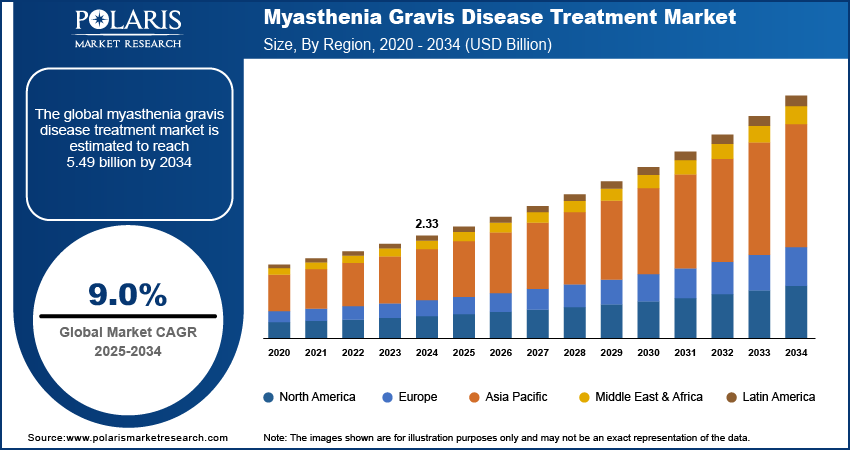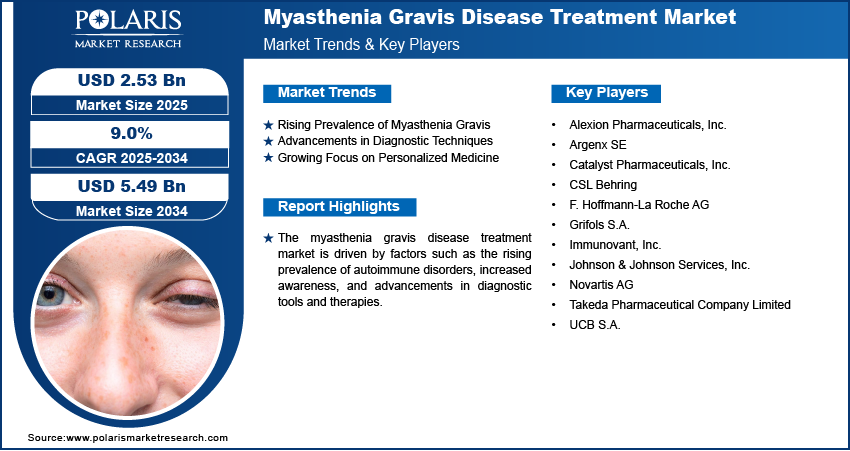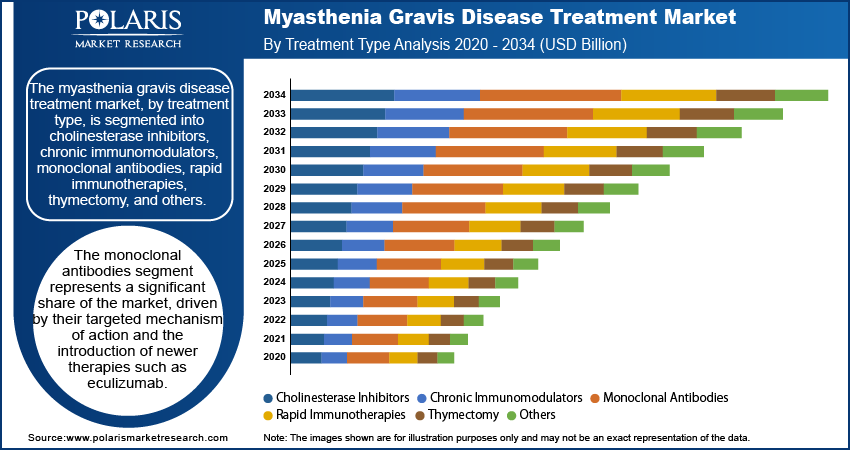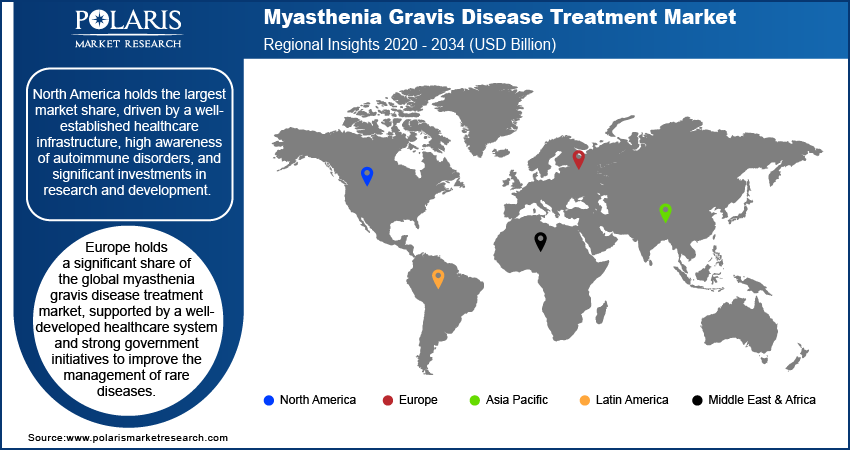
Myasthenia Gravis Disease Treatment Market Size, Share, Trends, Industry Analysis Report
: By Treatment Type (Cholinesterase Inhibitors, Chronic Immunomodulators, Monoclonal Antibodies, Rapid Immunotherapies, Thymectomy, and Others), Diagnosis, End Use, and Region (North America, Europe, Asia Pacific, Latin America, and Middle East & Africa) – Market Forecast, 2025–2034
- Published Date:Apr-2025
- Pages: 118
- Format: PDF
- Report ID: PM4026
- Base Year: 2024
- Historical Data: 2020-2023
Myasthenia Gravis Disease Treatment Market Overview
The myasthenia gravis disease treatment market size was valued at USD 2.33 billion in 2024. The market is projected to grow from USD 2.53 billion in 2025 to USD 5.49 billion by 2034, exhibiting a CAGR of 9.0% during 2025–2034.
The myasthenia gravis disease treatment market focuses on the development and provision of therapies for myasthenia gravis (MG), a chronic autoimmune neuromuscular disorder that causes weakness in the skeletal muscles. Key drivers of this market include the rising prevalence of MG, increasing awareness of autoimmune diseases, and advancements in diagnostic and treatment options. myasthenia gravis disease treatment market trends include the growing focus on personalized medicine, development of novel biologics, and the increasing use of monoclonal antibodies. Additionally, ongoing clinical trials and research initiatives aimed at improving treatment efficacy and patient outcomes are contributing to market growth.

To Understand More About this Research: Request a Free Sample Report
Myasthenia Gravis Disease Treatment Market Dynamics
Rising Prevalence of Myasthenia Gravis
The prevalence of myasthenia gravis (MG) is increasing across the world due to better diagnostic capabilities and growing awareness of the condition. According to the National Organization for Rare Disorders (NORD), MG affects ∼20 out of every 100,000 people worldwide. This rising prevalence of myasthenia gravis has led to greater demand for effective treatments and therapies, which, in turn, drives research and development efforts in the pharmaceutical industry. Hence, the increasing prevalence of the disease boosts the myasthenia gravis disease treatment market demand.
Advancements in Diagnostic Techniques
Innovations in diagnostic procedures such as more accurate antibody tests, including the detection of acetylcholine receptor (AChR) antibodies and muscle-specific kinase (MuSK) antibodies, have improved early diagnosis and patient management. A study published in the Journal of Clinical Neurology highlighted that these advancements have reduced the time to diagnosis and improved treatment outcomes, thereby increasing the demand for targeted therapies. Thus, rising advancements in diagnostic techniques have played a crucial role in fueling the myasthenia gravis disease treatment market development.
Growing Focus on Personalized Medicine
The growing focus on personalized medicine is transforming the myasthenia gravis treatment landscape. Personalized approaches, which consider individual patient profiles, genetic factors, and disease subtypes, are becoming increasingly prevalent. This shift is supported by advancements in genomic research and biotechnology, enabling the development of tailored therapies. According to a report by the Personalized Medicine Coalition, the adoption of personalized treatments has led to improved patient outcomes and a reduction in adverse drug reactions, which has fueled investment in this segment. Therefore, the rising focus on personalized medicine is expected to propel the myasthenia gravis disease treatment market growth during the forecast period.

Myasthenia Gravis Disease Treatment Market Segment Insights
Myasthenia Gravis Disease Treatment Market Assessment – Treatment Type-Based Insights
The myasthenia gravis disease treatment market segmentation, by treatment type, includes cholinesterase inhibitors, chronic immunomodulators, monoclonal antibodies, rapid immunotherapies, thymectomy, and others. The monoclonal antibodies segment represents a significant share of the myasthenia gravis disease treatment market revenue, driven by their targeted mechanism of action and the introduction of newer therapies such as eculizumab. This segment is gaining traction due to its ability to provide substantial clinical benefits in refractory cases. The segment is also expected to register the highest growth rate during the forecast period. The growing adoption of biologics, supported by clinical evidence and improved patient outcomes, is a key factor contributing to this segment’s expansion.
The chronic immunomodulators segment, such as corticosteroids and non-steroidal immunosuppressants, holds a considerable market share due to their established use in managing MG symptoms and preventing disease progression. These treatments continue to be widely prescribed, especially in cases where long-term management is necessary. Meanwhile, cholinesterase inhibitors, such as pyridostigmine, remain a cornerstone of symptomatic treatment, particularly in mild to moderate cases. The market dynamics are further influenced by advancements in rapid immunotherapies and increasing adoption of thymectomy in suitable patient populations, reflecting a comprehensive approach to managing this complex autoimmune disorder.
Myasthenia Gravis Disease Treatment Market Outlook – End Use-Based Insights
The myasthenia gravis disease treatment market, by end use, is segmented into hospitals, clinics, and others. The hospitals segment holds the largest market share, attributed to their comprehensive healthcare services, access to advanced diagnostic tools, and the availability of specialized treatment options. The hospital segment benefits from a higher patient influx for diagnosis and management of myasthenia gravis, particularly in severe cases requiring complex therapeutic interventions and continuous monitoring. Additionally, the presence of multidisciplinary teams in hospital settings enhances the quality of care, contributing to this segment’s dominance.
The clinics segment is anticipated to register the highest growth rate due to increasing accessibility and patient preference for outpatient care. Clinics offer convenience and faster access to specialists, making them an attractive option for routine management and follow-up consultations. The rise in the number of specialized neurology clinics and the adoption of telemedicine services are also driving the segment growth. Meanwhile, the others segment, which includes home care and rehabilitation centers, plays a crucial role in providing supportive care and improving the quality of life for patients, particularly those with chronic conditions requiring long-term management.

Myasthenia Gravis Disease Treatment Market Regional Insights
By region, the study provides myasthenia gravis disease treatment market insights into North America, Europe, Asia Pacific, Latin America, and the Middle East & Africa. North America dominates the global myasthenia gravis disease treatment market share, driven by a well-established healthcare infrastructure, high awareness of autoimmune disorders, and significant investments in research and development. The presence of key pharmaceutical companies and access to advanced diagnostic and therapeutic options further contribute to the region's dominance. Additionally, favorable reimbursement policies and a higher prevalence of myasthenia gravis in the region support myasthenia gravis disease treatment market expansion in the region. Europe follows closely, benefiting from similar factors to North America, whereas Asia Pacific is expected to witness the fastest growth during the forecast period due to increasing healthcare expenditure, improving diagnostic capabilities, and rising awareness about the disease.
Europe holds a significant share of the global myasthenia gravis disease treatment market revenue, supported by a well-developed healthcare system and strong government initiatives to improve the management of rare diseases. Countries such as Germany, the UK, and France are at the forefront due to their advanced medical infrastructure, widespread availability of treatment options, and ongoing clinical research. The European market also benefits from collaborative efforts within the European Union to enhance awareness, diagnosis, and treatment of myasthenia gravis, contributing to steady market growth in the region.
The Asia Pacific myasthenia gravis disease treatment market is poised for rapid growth during the forecast period, driven by increasing healthcare expenditures, improving healthcare infrastructure, and rising awareness about autoimmune diseases. Countries such as China, India, and Japan are witnessing significant advancements in diagnostic capabilities and the adoption of innovative therapies. Additionally, the growing prevalence of myasthenia gravis in this region, coupled with expanding access to healthcare services, is expected to fuel market expansion. Government initiatives aimed at strengthening healthcare systems and the increasing presence of global pharmaceutical companies in this region further support growth.

Myasthenia Gravis Disease Treatment Market – Key Players and Competitive Insights
The myasthenia gravis disease treatment market features several key players actively engaged in developing and providing therapies for myasthenia gravis. A few prominent companies include F. Hoffmann-La Roche AG; Novartis AG; Alexion Pharmaceuticals, Inc. (a part of AstraZeneca); and Grifols S.A., all of which have substantial portfolios in neurology and autoimmune disease treatments. Companies such as CSL Behring, UCB S.A., and Takeda Pharmaceutical Company Limited are also important players, contributing with their immunotherapy products and extensive research initiatives. Other notable participants, including Johnson & Johnson Services, focus on addressing unmet medical needs in neurology.
Companies such as Catalyst Pharmaceuticals, Inc., specializing in therapies for rare neuromuscular disorders, and Argenx SE, known for its innovative immunotherapy solutions contribute to the market expansion. Other active players include Otsuka Pharmaceutical Co., Ltd.; Immunovant, Inc.; and Viela Bio (acquired by Horizon Therapeutics plc), which are advancing their presence in the autoimmune segment through novel treatment options and clinical development.
The competitive landscape of the myasthenia gravis disease treatment market is characterized by a strong focus on innovation, strategic collaborations, and expanding therapeutic portfolios. Companies are increasingly investing in R&D to develop biologics, monoclonal antibodies, and personalized medicine approaches to improve treatment efficacy and patient outcomes. The market is also witnessing partnerships between pharmaceutical companies and research institutions aimed at accelerating the development of next-generation therapies. Additionally, the competitive environment is marked by the ongoing entry of new players and the introduction of innovative treatments, which are reshaping the dynamics of the market and enhancing patient care options.
F. Hoffmann-La Roche AG, a major player in the myasthenia gravis disease treatment market, is known for its strong focus on biotechnology and pharmaceuticals. The company has been actively involved in developing innovative treatments for autoimmune diseases, including myasthenia gravis.
Alexion Pharmaceuticals, Inc., a part of AstraZeneca, is another key participant in the market. Alexion has been a leader in developing therapies for rare and severe diseases, with its flagship product, eculizumab (marketed as Soliris), being widely used in the treatment of myasthenia gravis.
List of Key Companies in Myasthenia Gravis Disease Treatment Market
- Alexion Pharmaceuticals, Inc. (a part of AstraZeneca)
- Argenx SE
- Catalyst Pharmaceuticals, Inc.
- CSL Behring
- F. Hoffmann-La Roche AG
- Grifols S.A.
- Immunovant, Inc.
- Johnson & Johnson Services, Inc.
- Novartis AG
- Takeda Pharmaceutical Company Limited
- UCB S.A.
Myasthenia Gravis Disease Treatment Industry Developments
- In October 2024, Roche announced the initiation of a new clinical trial for an investigational therapy aimed at improving outcomes for patients with refractory myasthenia gravis, highlighting its commitment to advancing treatment options.
- In September 2024, Alexion received regulatory approval for an expanded indication of a newer therapy, demonstrating its ongoing efforts to enhance patient care in the neurology space.
Myasthenia Gravis Disease Treatment Market Segmentation
By Treatment Type Outlook (Revenue – USD Billion, 2020–2034)
- Cholinesterase Inhibitors
- Chronic Immunomodulators
- Monoclonal Antibodies
- Rapid Immunotherapies
- Thymectomy
- Others
By Diagnosis Outlook (Revenue – USD Billion, 2020–2034)
- Blood Tests
- Electrodiagnosis
- Edrophonium Test
By End Use Outlook (Revenue – USD Billion, 2020–2034)
- Hospitals
- Clinics
- Others
By Regional Outlook (Revenue – USD Billion, 2020–2034)
- North America
- US
- Canada
- Europe
- Germany
- France
- UK
- Italy
- Spain
- Netherlands
- Russia
- Rest of Europe
- Asia Pacific
- China
- Japan
- India
- Malaysia
- South Korea
- Indonesia
- Australia
- Vietnam
- Rest of Asia Pacific
- Middle East & Africa
- Saudi Arabia
- UAE
- Israel
- South Africa
- Rest of Middle East & Africa
- Latin America
- Mexico
- Brazil
- Argentina
- Rest of Latin America
Myasthenia Gravis Disease Treatment Market Report Scope
|
Report Attributes |
Details |
|
Market Size Value in 2024 |
USD 2.33 billion |
|
Market Size Value in 2025 |
USD 2.53 billion |
|
Revenue Forecast by 2034 |
USD 5.49 billion |
|
CAGR |
9.0% from 2025 to 2034 |
|
Base Year |
2024 |
|
Historical Data |
2020–2023 |
|
Forecast Period |
2025–2034 |
|
Quantitative Units |
Revenue in USD billion and CAGR from 2025 to 2034 |
|
Report Coverage |
Revenue Forecast, Market Competitive Landscape, Growth Factors, and Trends |
|
Segments Covered |
|
|
Regional Scope |
|
|
Competitive Landscape |
|
|
Report Format |
|
|
Customization |
Report customization as per your requirements with respect to countries, regions, and segmentation. |
How is the report valuable for an organization?
Workflow/Innovation Strategy: The myasthenia gravis disease treatment market has been broadly segmented on the basis of treatment type, diagnosis, and end use. Moreover, the study provides the reader with a detailed understanding of the different segments at both the global and regional levels.
Growth/Marketing Strategy: The myasthenia gravis disease treatment market growth and marketing strategy focuses on increasing awareness about the disease, enhancing diagnostic capabilities, and expanding access to advanced therapies. Companies are investing in research and development to bring innovative treatments to market, including biologics and personalized medicine. Strategic partnerships, collaborations with research institutions, and targeted marketing campaigns are also key components, aimed at reaching healthcare providers and patients. Additionally, efforts to secure favorable reimbursement policies and regulatory approvals are critical to driving market growth and ensuring broader patient access to emerging therapies.
FAQ's
The myasthenia gravis disease treatment market size was valued at USD 2.33 billion in 2024 and is projected to grow to USD 5.49 billion by 2034.
The market is projected to register a CAGR of 9.0% during the forecast period.
North America held the largest share of the market in 2024.
A few prominent companies include F. Hoffmann-La Roche AG; Novartis AG; Alexion Pharmaceuticals, Inc. (a part of AstraZeneca); and Grifols S.A. All of these players have substantial portfolios in neurology and autoimmune disease treatments. Companies such as CSL Behring, UCB S.A., and Takeda Pharmaceutical Company Limited are also important players, contributing with their immunotherapy products and extensive research initiatives
The monoclonal antibodies segment accounted for the largest share of the market in 2024.
Myasthenia gravis (MG) is a chronic autoimmune disorder that causes weakness in the skeletal muscles, particularly those that control voluntary movements such as the muscles used for breathing, swallowing, and eye movement. The condition occurs when the body's immune system attacks and disrupts the communication between nerves and muscles by targeting the acetylcholine receptors at the neuromuscular junction. Treatment for myasthenia gravis aims to improve muscle strength, reduce symptoms, and manage the underlying immune response. These treatments may include medications such as cholinesterase inhibitors, immunosuppressive drugs, monoclonal antibodies, and therapies, including plasmapheresis or intravenous immunoglobulin (IVIG). In some cases, surgical options such as thymectomy, the removal of the thymus gland, may be considered to improve outcomes.
A few key trends in the market are described below: Growth of Biologics and Monoclonal Antibodies: Increasing adoption of targeted therapies, such as monoclonal antibodies, which offer more effective treatment for refractory cases. Personalized Medicine: A shift toward personalized treatment plans based on genetic and molecular profiling, enabling more tailored and effective therapies. Increasing Clinical Trials and Research: Surge in clinical trials focused on improving treatment efficacy and exploring novel therapies for myasthenia gravis. Immunotherapy Advancements: Expansion in the use of immunotherapies, including intravenous immunoglobulin (IVIG) and plasmapheresis, to manage acute exacerbations and reduce autoimmune activity.
A new company entering the myasthenia gravis disease treatment market could focus on developing innovative, targeted therapies such as advanced biologics or monoclonal antibodies, addressing gaps in current treatment options, particularly for refractory cases. Investing in personalized medicine, leveraging genetic and biomarker-driven approaches, could help offer tailored treatments that enhance patient outcomes. Additionally, the company could focus on improving diagnostic tools for earlier and more accurate detection, which would support timely interventions. Forming strategic partnerships with research institutions and healthcare providers would also be key to accelerating product development and gaining market access. Moreover, addressing unmet needs in areas such as affordability and patient support services could strengthen its position in a competitive market.
